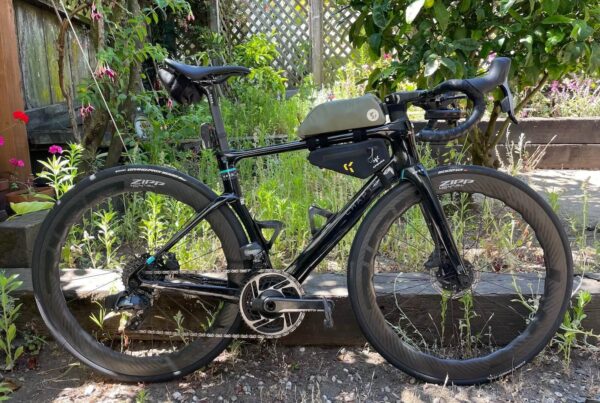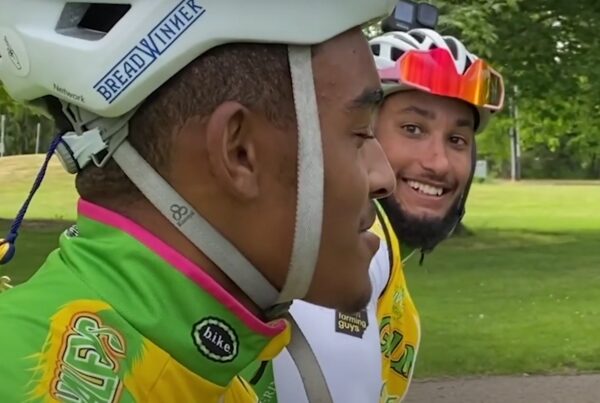After a skidding jeep slammed into 21 year-old Joshua Clark, sending him to the hospital with a possible head injury, the Durango, Colorado police indicated that they would probably not issue a ticket to Clark, who they determined to be at fault, explaining that “he’s going to have some tremendous hospital bills.”
Without a doubt, the Durango Police thought they were doing the injured cyclist a favor. And if Clark had been breaking the law, they would undoubtedly be doing him a favor. But was he breaking the law?
I have my doubts.
As the Jeep driver and a couple of other independent witnesses explained, on the evening of April 23rd, Clark “came up to the pedestrian crosswalk paused, then for whatever reason, rode his bike into the crosswalk and oncoming traffic.”
According to the police, this was illegal:
“Because he was riding his bicycle in the crosswalk instead of walking, he’s at fault for failing to yield,” [Sgt. John] Ball, the patrol supervisor, said about Clark. “We probably won’t cite him because he’s going to have some tremendous hospital bills. If he had dismounted and walked, he would have been entitled to all the privileges of a pedestrian, but when you ride in a crosswalk, you’re at fault.”
So, according to the police, if Clark had dismounted and walked across, he would have had the right of way, and the approaching drivers would have been required to yield to Clark. It was only because he rode across the intersection in the crosswalk that police alleged that he was at fault for failing to yield. And thus, because Clark failed to yield, and “rode his bike into the crosswalk and oncoming traffic,” the approaching Jeep skidded 50 feet before slamming into Clark in the crosswalk.
Call me a skeptic. I thought I’d take a look at Colorado law to see if it’s really true that cyclists have to dismount and walk in the crosswalk. And what do you think I found? There is no such requirement in Colorado law. In fact, the law allows cyclists to ride in the crosswalk unless local law or an official traffic control device prohibits it.
Well, OK, I thought, maybe it’s against the law in Durango to ride in the crosswalk.
Nope.
Completely legal, unless an official traffic control device prohibits it.
So I took a look at the intersection, courtesy of Google Street View. Maybe, I thought, there’s a posted sign requiring cyclists to dismount and walk across the intersection.
Again, no.
But there are posted signs requiring drivers to yield to persons in the crosswalk.
And yet police decided that the cyclist was at fault for violating a law that doesn’t exist—and then gave him a break by not giving him a ticket.
Of course, what we’ve heard so far is the driver’s account. And that’s all we’re likely to hear. As Sgt. Ball explained, “the bicycle rider got his noggin thumped and didn’t remember what had happened.”
But there’s one more interesting analysis that might help to shed some light on what happened. Commenting on the collision, a Durango Herald reader who identifies himself as a former automotive engineer claims that the skid mark indicates that the driver was “doing closer to 50mph than 35mph,” and argues that the Durango Police need to investigate the skid mark more thoroughly. “If they can’t produce a 50 foot skid from a Jeep doing the 35mph speed limit, then the driver should be cited for excessive speed,” the reader asserts. “No cyclist intentionally endangers their own life by pulling in front of a speeding car,” he continues. “[The driver would] have to be significantly over the limit for a cyclist to so badly misjudge the time available to cross.”
This is exactly right. But before the Durango Police can conduct a proper analysis of what happened, they first have to stop clinging to a law that doesn’t exist.




And here I thought Durango was supposed to be high on the list of ‘bike-friendly’ cities/towns in the US, certainly in Colorado; sad.
Hey, Durango PD, do us ALL a favor, and LEARN YOUR JOB!
I was pulled over by a cop in Sandwich Massachusetts on Cape Cod. The cop was making up all sorts of imaginary laws. I politely corrected him each and every time and stating the actual law. After a half hour of this he finally let me go.
Where bicyclists are permitted to use crosswalks, they have to follow pedestrian rules. Even when they have the right of way at crosswalks, one of these rules is “No pedestrian shall suddenly leave a curb or other place of safety and ride a bicycle, ride an electrical assisted bicycle, walk or run into the path of a moving vehicle that is so close as to constitute an immediate hazard.” (This is the Colorado version, which specifically mentions bicycles —
https://www.colocode.com/fctc/fctc_08.pdf
Yes, the driver may have been speeding also, but the police are not so wrong as you suggest. In this situation, the bicyclist should have stopped and waited for the driver to stop or pass by. I also suggest indicating intent to cross by pointing.
Regardless of speed limits, if a driver of a car cannot safely stop for someone in a crosswalk, they were going too fast. If they claim that the person jumped into the road suddenly, I’d say it’s still partially the fault of the driver for not being more aware that someone was near the crosswalk. It is so incredibly easy to pay attention and drive a safe speed, but people insist of spending their mental resources doing junk other than paying attention to where their 2 ton vehicle is going. If you hit someone, then by definition you were going “too fast.”
It’s pretty easy to enter a crosswalk too fast for someone to stop — even too fast for a driver who is not speeding — if you are entering on a bicycle, especially if you do not stop.
Paul, my point is that if you are unable to see that, you should drive slower, and the speed limit should be lowered. There is no law that says that people driving in cars should always have the unlimited ability to drive the speed limit with no obstacles. In fact, most every law is limiting that ability in hopes of assuring some amount of safety. Where intersections exist where cycling on the sidewalk and through crosswalks is legal (not always the case in cities), then speed limits need to be reduced, and the view around corners should be improved in any way possible. While a cyclist or pedestrian certainly should not just enter a crosswalk without looking down the road first, a car driver should also never be going fast enough to make that an issue. As this article states, cyclists and pedestrians are intentionally endangering themselves either.
When driving, I look ahead at crosswalks to make sure that I’m not endangering someone’s life – it’s easy, takes no additional time (in the scheme of things, I’m bound to reach the same stop or light anyway). What most drivers don’t realize is that going 30 rather than 20 in an urban environment will rarely yield them any benefit.
That “Durango Herald reader who identifies himself as a former automotive engineer” and says the length of the skid mark indicates the Jeep was doing closer to 50mph than 35mph” is wrong. According to “Traffic Accident Investigation Manual” by Stannard (the standard reference on estimating speed from skid marks), a skid to a stop that is 50′ long for a car with good brakes on dry pavement indicates a speed of 35 mph, not 50.
Sorry, meant to say “As this article states, cyclists and pedestrians AREN’T intentionally endangering themselves either.”
Paul, we are well aware of the rule regarding pedestrians (and cyclists) safely entering a crosswalk.
But do the police allege that he entered the crosswalk in violation of that law? No. In fact, the police state that if he had been on foot, he would have been entitled to all the privileges of a pedestrian. This implies that in the view of the police, the driver would have been required to stop and yield. But even if that is not quite what the police meant, at a minimum, it means that police would have conducted an investigation to determine whether the driver or the pedestrian was in violation of the law.
And that is as it should be.
What should not happenbut unfortunately, did happen in this caseis for the police to take down the drivers account, allege that the cyclist violated an imaginary law, and end the investigation there.
I think the facts of the case warrant much more in the way of investigation.
First, the cyclist entered the crosswalk. Was he legally in the crosswalk? This is not only a legitimate question for the investigation, it is a necessary question. But the question isnt whether he was riding or walking; the question is whether he had the legal right of way when he entered the crosswalk. Was the approaching traffic so close that it constituted an immediate hazard? If approaching traffic was too close, then he had no right to enter the crosswalk. If approaching traffic was not too close, then he was legally entitled to enter the crosswalk, and the driver was required to stop and yield.
Second, was the driver observing the speed limit? This has a bearing on the investigation, because a driver who is far enough from the crosswalk so as not to constitute an immediate hazard, AND who is observing the speed limit, is capable of stopping and yielding. On the other hand, a driver who is far enough from the crosswalk, but is NOT observing the speed limit, may not be capable of stopping and yielding. Furthermore, what constitutes a safe distance can be deceptive to the pedestrian when the driver is speeding.
Now what seems more likely? That the cyclist saw that approaching traffic was so close that entering the crosswalk would be suicidal, but entered the crosswalk anyway? Or that the cyclist saw what looked like a vehicle at a safe distance, but was deceived by the drivers speed?
And likelihoods aside, how would we know which was the case?
By an investigationthe kind that should have been conducted, but for the imaginary law that the police relied upon to pre-determine fault.
Paul-
The cyclist did not enter the crosswalk without stopping. Even the witnesses agree that he stopped, paused, and then entered the crosswalk.
Bob-
According to the former automotive engineer, the type of skid mark left indicates that (1) the Jeep has ABS brakes; (2) the brakes were strongly applied in a panic stop; and (3) the combination of one tire alternating between skidding and rolling and three tires rolling means that “the the car should have stopped in far less than 50′ provided it was ”only” doing 35mph.”
Given that this contradicts what you are saying, the question then becomes whether Stannard is referring to a 50 foot skid by a car with ABS brakes, or conventional brakes.
And even if Stannard is referring to a car with ABS brakes, rather than conventional brakes, consider what would happen at trial, where both parties are entitled to present their own experts. It is common for one expert to contradict another.
Of course, this can cut both ways, but my point is that a chart may or may not help us get to the truth of what happened. One has to ask questions about the data, and the analysis, to get to what we think the truth might be.
If you check the math, I think you’ll find a vehicle moving at 35 mph will stop in 50 ft. The fact that the Jeep was still moving fast enough to injure the cyclist indicates a higher speed.
No cyclist intentionally endangers their own life by pulling in front of a speeding car, he continues..
Really!? I have seen them riding on the wrong side of the street, in the dark jetting out in front of vehicles, of course the bicycles have no lights on them. I really believe pedumbstrians and cyclists put there own self in danger on purpose.
To clarify the pedumbstrian comment above, I call the those ones that endanger there own life because they don’t look bothways before stepping in a roadway, or have cellphones out, or headphones on, or can’t be bothered to stop and look when jogging, just plain careless behavior. They go above and beyond on educating the motor vehicle operators, but they just tell these careless pedumbstrians to just do as you please, you have the right of way! NO you don’t! Not completely, they need to re-educate pedumbstrians to be pedestrians again and learn how to cross a street properly as it is not a play area!
Brian, you should realize that almost every single person is a pedestrian at some point. And I doubt the majority of people ever completely behave the way you are expecting them to behave. So firstly, you are then calling most pedumstrians. Secondly, most of these said pedumstrians are also drivers. So what does that make drivers? A pedumstrian operating a 2 + ton vehicle capable of dealing massage bodily/property damage. Well no wonder traffic fatalities in this country is close to 40,000 a year.
John, go back and re-read why I call them pedumbstrians.
Yes we all maybe one at some point, but that shouldn’t excuse bad behavior pedumbstrians exhibit.
Also I have seen very dangerous motor vehicle operating too, so its a problem with all 3 groups across the board.